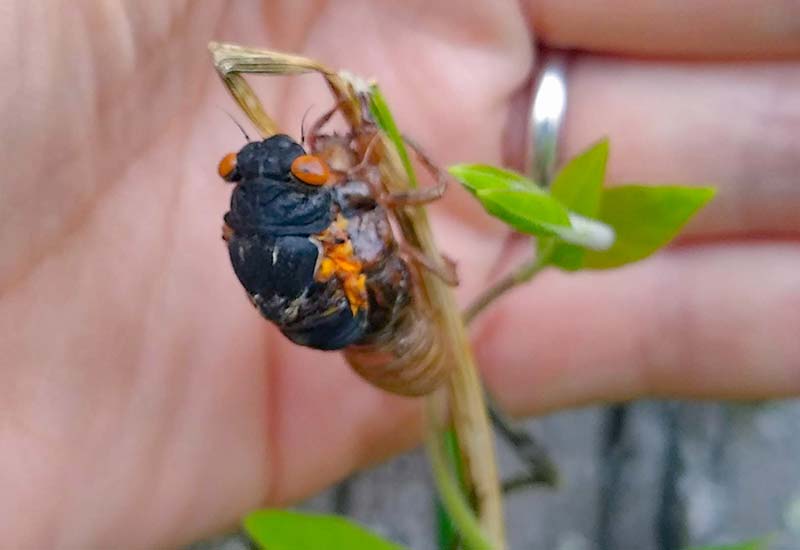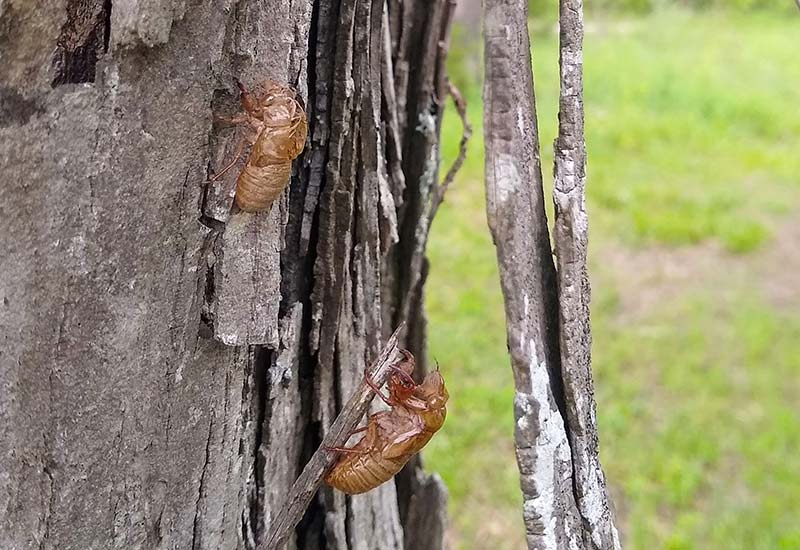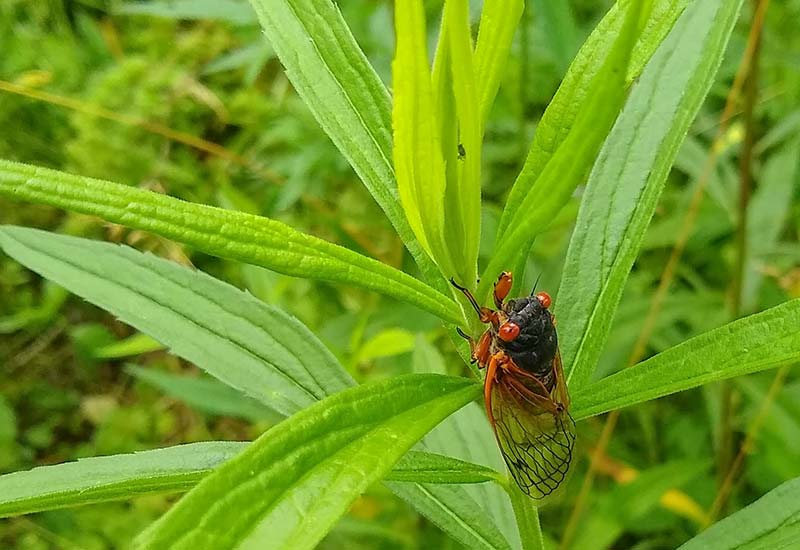But have no fear.
These red-eyed bumbling insects aren’t dangerous to people, pets or crops.
In fact, they’re tasty to wildlife and fish, who feast on their crunchy exoskeletons by the millions.
And they’re part of a natural cycle that’s been going on for millennia.
Last year brought 13-year Brood XIX cicadas Valley-wide.
2025 brings a larger, more widespread emergence of 17-year Brood XIV to the northern parts of the Tennessee Valley Authority’s seven-state service area from May to June.
And if people aren’t in the path this year, just wait.
Different broods of 13- and 17-year cicadas hatch in different parts of the Valley region in upcoming spring seasons.
“(Cicada hatching) connects us to the natural world,” Jesse Troxler, Tennessee Valley Authority terrestrial zoologist, said. “Wherever you’re located, you’re going to get a different emergence, and you may not see them again for a long time.”

Cicada Cycles
North Americans regularly hear the warm-weather whine of two types of cicadas – annual and periodical.
Annual cicadas sing every year during the sultry dog days of summer, when the Dog Star Sirius rises in the sky.
Periodical cicadas – the kind that makes up the different broods that emerge in cycles – live on their own quirky timelines.
In the southern parts of TVA’s service area, four species of the southern 13-year cicadas emerge. In northern areas, broods made of three species of 17-year cicadas are more common, although their territories overlap.
Why the different timelines in different regions?
Some scientists think past glaciation may have set these cycles in motion.
Still others think cicadas are in stealth mode – they emerge after long, prime-number intervals so they don’t sync up with other animals’ life cycles.
And these cyclical cicadas count on sheer numbers, too. Raccoons, bass, crows and others can gorge themselves on the nutty-flavored nuggets and still leave plenty of surviving insects to breed.
Whatever the reasons, this season of emerging periodical cicadas is special.
“Cicadas are such an awesome event in nature,” TVA terrestrial zoologist Maria Aguirre said. “They spend 99% of their life underground and just come out for just a little bit to mate.”
This year, residents of certain spots in Tennessee, Kentucky and North Carolina will spot Brood XIV, made up of species in the Magicicada genus. This particular group last hatched in 2008 in the eastern and southeastern United States – and was first recorded by the Pilgrims in Plymouth in 1634.
People will have to look closely to see a difference in cicada species, though.
Even side by side, the seven cicada species look almost alike.
Some, like the Cassini group – also called dwarf cicadas – have smaller bodies.
And some sound different. The Pharaoh gets its name from its long croak, “Phaaaaraoh,” Troxler explained.
Aguirre had some advice for people wary of insects.
“I think they should see (the emergence) as natural and interesting,” she said. “If you don’t like bugs, I get it. But just don’t bother them. They won’t bother you. They’ll just be a little loud, but please don’t spray them. Cicadas are just really cool.”

Tuned Into Timing
Cicadas know the weather and calendar. They claw their way to daylight when the soil hits exactly 64 degrees at 8 inches underground – on exactly the 13th or 17th year after they hatched.
“They’ll tunnel to the surface and make holes there,” Troxler said. “Then everybody’s getting ready – waiting, waiting, waiting. Once they get a good rain, it’s go time.”
Go time means the wingless larvae carefully climb with hooked feet up a rough vertical surface, such as a tree or brick wall, to molt the tan husk of their outer skin.
“They’ll split that exoskeleton and their wings will emerge,” Troxler said. “They’ll unfold them (and) pump fluid into those wings. They just inflate them like a bicycle tire. They’ll be there for a couple of hours drying out before they can actually fly.”
Then the weeks-long frenzy begins. Males create a whirring, overlapping chorus, filling the forest with a love song to female cicadas.
“The male has clapper organs called tymbals on its abdomen called tymbals, and it’s mainly hollow on the inside, so that the sound can reverberate,” Aguirre said.
Females click back and, after their eggs are fertilized, climb to the tender tips of branches.
“Then they’ll saw a little slit into the twig and deposit their eggs inside,” Troxler said. “It doesn’t affect mature trees. They’re strong enough to take that hit.”
Still, he advised, homeowners may want to cover tiny trees with nursery cloth.
In the big picture, cicadas help forests, Shannon O’Quinn, TVA senior water resources specialist and avid fly fisher, said. “The million cicadas that were in that tree, they all die and fertilize that tree afterwards.”
The event isn’t over even after the singing has stopped.
“In July, August, you can see the eggs, hatching from the tree branches and falling onto the ground,” Aguirre said. “All the little eggs coming down look misty.”
Baby cicadas dig down into the soil, bidding the sun goodbye for another 13 to 17 years, and the cycle begins again.
Awesome Animals
Cicadas are best known for their timing, but they play a bigger role in ecosystems, too.
Besides providing food for wildlife and trees, cicadas dig tunnels that let air and water into the soil. Birds even leave or adjust when they sing, and at what frequency, so as not to compete with the noisy insects.
And eager fly fishers await cicadas, too.
Avid casters tie flies to mimic the bugs’ bulky bodies and colors, then float fishing lines over shallow waters of reservoirs and tailwaters to reel in trout, bass and non-native common carp.
Across the Valley region and continent, cicadas’ songs tell of long-term biodiversity.
“If (the cicadas) are there, that means that that ecosystem has been pretty stable,” Aguirre said.
Older parks and wooded backyards are the best places to see and hear them.
“You’re looking for an area with lots of mature deciduous trees – the kind that lose their leaves in the fall,” Troxler said. “The bigger, more mature trees … the more chance you have of cicadas. They go back 17 years, 34 years, 51 years.”
People can become community scientists and add cicada sightings to Cicada Safari, iNaturalist or other nature tracking apps this spring, as well as look forward to upcoming emergences in their area.
“We all spend most of our time inside these days,” Troxler said. “The more that you’re aware of what’s going on outside of your walls, the more you’ll take care of it.”

